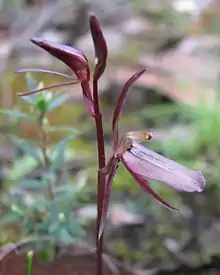Cyrtostylis reniformis
Cyrtostylis reniformis, commonly known as common gnat-orchid,[2] is a species of orchid endemic to eastern Australia. It usually has a single kidney-shaped leaf and a flowering spike with up to eight reddish flowers with a shelf-like labellum. Cyrtostylis huegelii is a similar species occurring in Western Australia and which some authorities regard as a synonym of Cyrtostylis reniformis var. huegelii.
| Common gnat orchid | |
|---|---|
 | |
| Cyrtostylis reniformis in Brisbane Ranges National Park, Victoria | |
| Scientific classification | |
| Kingdom: | Plantae |
| Clade: | Tracheophytes |
| Clade: | Angiosperms |
| Clade: | Monocots |
| Order: | Asparagales |
| Family: | Orchidaceae |
| Subfamily: | Orchidoideae |
| Tribe: | Diurideae |
| Genus: | Cyrtostylis |
| Species: | C. reniformis |
| Binomial name | |
| Cyrtostylis reniformis | |
| Synonyms[1] | |
Description
Cyrtostylis reniformis is a terrestrial, perennial, deciduous, herb with a single kidney-shaped, heart-shaped or almost round leaf 15–40 mm (0.6–2 in) long and 10–30 mm (0.4–1 in) wide. Up to eight dark reddish brown, or rarely yellowish flowers 11–14 mm (0.4–0.6 in) long are borne on a flowering stem 50–150 mm (2–6 in) high. The dorsal sepal is erect and curved forward, linear to lance-shaped, 11.5–13 mm (0.5–0.5 in) long and about 2 mm (0.08 in) wide. The lateral sepals are linear, 10–11 mm (0.4–0.4 in) long, about 1 mm (0.04 in) wide and curve forwards or downwards. The petals are similar in size and shape to the lateral sepals and curve downwards. The labellum is oblong, 10–12.5 mm (0.4–0.5 in) long and about 5 mm (0.20 in) wide and shelf-like with a few serrations near its pointed tip. Flowering occurs from May to October.[2][3]
Taxonomy and naming
Cyrtostylis reniformis was first formally described in 1810 by Robert Brown and the description was published in Prodromus Florae Novae Hollandiae et Insulae Van Diemen.[4] The specific epithet (reniformis) is derived from the Latin ren, genitive renis meaning "kidney" and forma meaning "shape".[5]
Varieties
Two varieties are currently recognized as of April 2018:[1]
- Cyrtostylis reniformis var. huegelii (Endl.) Benth. is regarded as Cyrtostylis huegelii Endl. by some authorities.[2][6][7] It is differentiated by having smaller flowering structures, brownish colouration on the leaves and flowers. The distribution is predominantly coastal plains, and inland to forests in Western Australia from Kalbarri to Esperance, on lateric or granitic soils, sand in coastal heaths, and on Jarrah and Marri forest floors. It favours moist and shaded habitat, and often forms small, sometimes circular, colonies whose leaves lie against the ground. Those plants in the group which flower will reach a height of between 100 and 300 mm. Flowering is between July and September
- Cyrtostylis reniformis var. reniformis is a more robust species occurring in the eastern states.
Distribution and habitat
The eastern Australian variety of C. reniformis is widespread and locally common from coastal scrub to inland forest and heath. It occurs in Queensland, New South Wales, the Australian Capital Territory, Victoria, South Australia and Tasmania.[2][3]
References
- "Cyrtostylis reniformis". World Checklist of Selected Plant Families (WCSP). Royal Botanic Gardens, Kew.
- Jones, David L. (2006). A complete guide to native orchids of Australia including the island territories. Frenchs Forest, N.S.W.: New Holland. p. 164. ISBN 1877069124.
- Weston, Peter H. "Cyrtostylis reniformis". Royal Botanic Garden Sydney. Retrieved 30 April 2018.
- "Cyrtostylis reniformis". APNI. Retrieved 30 April 2018.
- Backer, C.A. (1936). Verklarend woordenboek der wetenschappelijke namen van de in Nederland en Nederlandsch-Indië in het wild groeiende en in tuinen en parken gekweekte varens en hoogere planten (Edition Nicoline van der Sijs).
- Hoffman, Noel; Brown, Andrew (2011). Orchids of South-West Australia (3rd ed.). Gooseberry Hill: Noel Hoffman. p. 272. ISBN 9780646562322.
- "Cyrtostylis huegelii". FloraBase. Western Australian Government Department of Parks and Wildlife.
External links
 Media related to Cyrtostylis reniformis at Wikimedia Commons
Media related to Cyrtostylis reniformis at Wikimedia Commons
